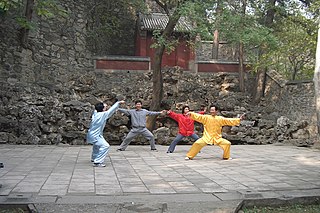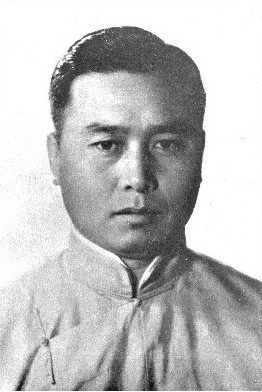Taiji,Tai chi, t'ai chi or 太極 may refer to:
Contents
- Tai chi, an internal Chinese martial art practiced for self-defense and health.
- Taiji (philosophy), a concept in Daoist philosophy
Taiji,Tai chi, t'ai chi or 太極 may refer to:

Neijia is the collective name for the internal Chinese martial arts. It relates to those martial arts occupied with spiritual, mental or qi-related aspects, as opposed to an "external" approach focused on physiological aspects. The distinction dates to the 17th century, but its modern application is due to publications by Sun Lutang, dating to the period of 1915 to 1928. Neijing is developed by using neigong or "internal changes", contrasted with waigong or "external exercises".

Tai chi is an internal Chinese martial art practiced for self-defense and health. Known for its slow, intentional movements, tai chi has practitioners worldwide and is particularly popular as a form of gentle exercise and moving meditation, with benefits to mental and physical health.

Zhang Sanfeng refers to a legendary Chinese Taoist who many believe invented tai chi. However, other sources point to early versions of tai chi predating Sanfeng. He was purported to have achieved immortality.

Cheng Man-ch'ing or Zheng Manqing was a Chinese expert of tai chi, Chinese medicine, and the so-called three perfections: calligraphy, painting and poetry. He was born in Yongjia, Zhejiang Province, during the Qing dynasty. Cheng died March 26, 1975; his grave is near the city of Taipei in Taiwan.

Hong Taiji, also rendered as Huang Taiji and sometimes referred to as Abahai in Western literature, also known by his temple name as the Emperor Taizong of Qing, was the second khan of the Later Jin dynasty and the founding emperor of the Qing dynasty. He was responsible for consolidating the empire that his father Nurhaci had founded and laid the groundwork for the conquest of the Ming dynasty, although he died before this was accomplished. He was also responsible for changing the name of the Jurchen ethnicity to "Manchu" in 1635, and changing the name of his dynasty from "Great Jin" to "Great Qing" in 1636. The Qing dynasty lasted until 1912.

In Chinese philosophy, taiji is a cosmological state of the universe and its affairs on all levels, involving the interaction of Yin and Yang, the Five Phases and finally, all the concrete things in the universe. More concretely, taiji is a conceptual current throughout religious and philosophical traditions indigenous to China, contemperaneously studied and applied in the profession of acupuncture, and within traditional Chinese medicine throughout and beyond the Sinosphere.

Jeong Hyeon-cheol, better known as Seo Taiji or Seo Tae-ji (서태지), is a South Korean singer, musician, songwriter and record producer. After dropping out of high school to pursue a music career, he rose to become one of the most prominent and influential cultural icons in South Korea, with many referring to him as "the President of Culture".

Yang-style tai chi is one of the five primary families of tai chi. Including its variations, it is the most popular and widely practised style of tai chi in the world today. It is second in terms of seniority, after Chen-style tai chi.

The Chen-style tai chi is a Northern Chinese martial art and the original form of tai chi. Chen-style is characterized by silk reeling, alternating fast and slow motions, and bursts of power.

Wu Jianquan was a famous teacher and founder of the neijia martial art of Wu-style tai chi in late Imperial and early Republican China.

Wu Quanyou was an influential teacher of tai chi in late Imperial China. His son is credited as the founder of the Wu-style tai chi. As he was of Manchu descent, and would have been named by his family in Manchu, the name "Wú" (吳) was a sinicisation that approximated the pronunciation of the first syllable of his Manchu clan name, U Hala.

Wu Daqi or Wu Ta-ch'i (1926–1993) was the descendant of the famous Wu-style tai chi founders Wu Quanyou (1834–1902) and Wu Jianquan (1870–1942). He directed Wu-style tai chi instruction outside of Mainland China after the death of his father Wu Gongyi (1900–1970) and brother Wu Ta-kuei (1923–1972) from the Wu-style tai chi headquarters in Hong Kong internationally.
Taijijian is a straight two-edged sword used in the training of the Chinese martial art tai chi. The straight sword, sometimes with a tassel and sometimes not, is used for upper body conditioning and martial training in traditional tai chi schools. The different family schools have various warmups, forms and fencing drills for training with the jian.

The tai chi classics are a collection of over 100 articles on the Chinese martial art of tai chi written by the art's master practitioners over the centuries. They cover everything from the underlying taiji philosophical principles, to methods of practice and application. Previously passed down in secret from generation to generation in whole or in parts through various lineages, they achieved classical status as they became public starting in the mid-1930s. Together they now serve as the single authoritative guide for the development and usage of tai chi skills. Written mostly in classical Chinese, they are used today mostly by the serious martial art practitioners of modern 6 Lineages that all trace their lineages to the ancient style taught by the Chen family and Yang family starting in the mid-19th century.
Jinan is the capital of Shandong province, China.
The different slow-motion solo form training sequences of tai chi are the best-known manifestations of tai chi for the general public. In English, they are usually called the hand form or just the form. In Mandarin, it is usually called quan.

Yang Luchan, also known as Yang Fukui (1799–1872), was an influential Chinese practitioner and teacher of the internal style tai chi. He is known as the founder of Yang-style tai chi, the most popular and widely practised tai chi style in the world today.

Dong Huling was a master of tai chi, known for teaching Yang style and Dong style, and an early leader in the spread of tai chi worldwide. Born in Ren County, Hebei, China, his father Dong Yingjie was a top disciple of Yang Chengfu and famous for his fighting skills. Also highly skilled and creative himself, Dong Huling taught in mainland China, Hong Kong, Macau, Southeast Asia, North America, and Europe. He then emigrated to Hawaii, founding a school in Honolulu, continued teaching workshops around the world, and carried on the Dong family legacy.

Wu-style tai chi is one of the five main styles of tai chi. It is second in popularity after Yang-style, and the fourth-oldest of the five major tai chi styles. It was developed by Wu Quanyou and Wu Jianquan.
Cheng Wing Kwong was a disciple (Tudi) of Wu Jianquan, the founder of Wu Style Taijiquan. He was born in Niao Shi, Zhongshan, Guangdong, China.